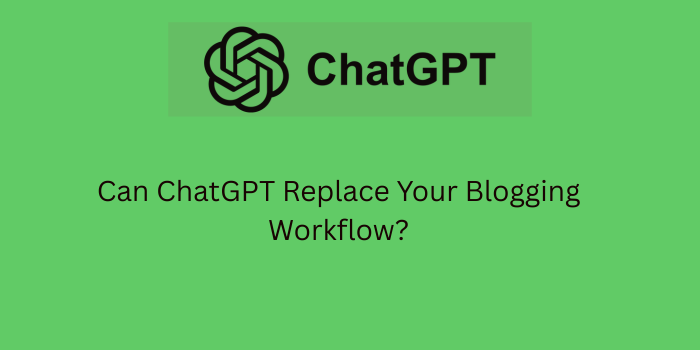Artificial intelligence has rapidly become a vital tool for content creators, digital marketers, and bloggers. Among AI tools, ChatGPT by OpenAI stands out for its ability to generate high-quality text, mimic human tone, and streamline entire content workflows. But the real question remains—can ChatGPT actually replace your blogging workflow?
In this in-depth article, we’ll explore the potential of ChatGPT as a blogging assistant or even a full replacement for traditional blog writing tasks. We’ll look into its strengths, limitations, and best practices so you can make the most of this AI revolution.
What is ChatGPT?
ChatGPT is an AI language model developed by OpenAI that uses natural language processing (NLP) to understand prompts and generate human-like responses. It’s commonly used for content creation, coding, summarizing, ideation, customer service, and more.
When it comes to AI blogging tools, ChatGPT leads the pack due to its flexible writing style, speed, and wide training data. Many bloggers are turning to it to boost productivity and improve their content strategy.
What Does a Blogging Workflow Typically Include?
Before determining whether ChatGPT can replace your workflow, it’s important to understand the typical blogging process:
- Topic brainstorming
- Keyword research and SEO planning
- Content outline creation
- Draft writing
- Editing and proofreading
- Image generation and formatting
- Publishing and promotion
Let’s evaluate how well ChatGPT performs in each of these areas.
1. Topic Brainstorming with ChatGPT
ChatGPT is an excellent tool for blog topic ideation. By feeding it a niche or seed keyword, you can instantly get a list of fresh blog ideas tailored to your audience.
Example Prompt: “Give me 10 blog post ideas for a personal finance blog.”
Why it works: The AI pulls from a wide array of content types and trends, making it great for sparking creative angles you might not have thought of.
2. SEO Optimization and Keyword Integration
ChatGPT can suggest and integrate keywords naturally within your content. While it doesn’t do deep analytics like Ahrefs or SEMrush, it understands how to incorporate SEO-friendly language.
Pro Tip: Pair ChatGPT with a dedicated SEO tool to get the best of both worlds—data-driven keywords and fluent writing.
3. Content Outlining and Structuring
A clear outline is crucial for an effective blog post. ChatGPT can quickly create content structures that include H1, H2, H3 tags, intros, conclusions, and even CTAs.
Example Prompt: “Create an SEO-optimized outline for a blog post about ChatGPT for email marketing.”
4. Draft Writing: Can ChatGPT Replace the Human Writer?
This is where ChatGPT shines. It can write entire blog posts that are coherent, readable, and keyword-rich. Depending on your input, it can adopt a formal, conversational, or technical tone.
Benefits:
- Faster content creation
- Consistency in tone and voice
- Reduction in writer’s block
Limitations: While ChatGPT can write well, it may sometimes produce generic content or repeat ideas. Always review the draft for accuracy and brand alignment.
5. Editing and Proofreading with AI
ChatGPT can also help edit drafts. By feeding it a paragraph and asking for improvements, you can get suggestions for clarity, grammar, or even tone adjustments.
However, combining it with tools like Grammarly or Hemingway can provide more granular feedback on readability and structure.
6. Image Suggestions and Formatting
While ChatGPT can’t generate images natively (unless integrated with tools like DALL·E), it can suggest what kind of visuals to use, write image alt text, and describe graphics for blog use.
Example Prompt: “Suggest 5 image ideas for a blog post about remote work productivity.”
7. Publishing and Promotion
ChatGPT can assist in writing:
- Meta titles and descriptions
- Social media captions
- Email newsletter blurbs
- Call-to-action sections
This streamlines your promotional workflow, especially when you’re distributing content across multiple channels.
Benefits of Using ChatGPT in Your Blogging Workflow
Integrating ChatGPT into your content creation process can lead to a more streamlined, consistent, and efficient blogging workflow. Whether you’re a solo blogger or part of a content team, AI can help you meet publishing goals faster without compromising quality.
- Speed: Cut down writing time significantly.
- Cost-efficiency: Reduce need for freelancers or writers.
- Scalability: Generate more content, more often.
- Versatility: Use for multiple formats—blogs, newsletters, social media.
When You Still Need a Human Touch
While ChatGPT is powerful, certain aspects of content still benefit from human oversight:
- Brand Voice: Fine-tuned tone that aligns with your brand
- Authenticity: Personal stories and lived experiences
- Fact-Checking: Ensuring accuracy of stats or references
- Emotional Nuance: Connecting deeply with your audience
Best Practices for Using ChatGPT for Blogging
To get the most out of ChatGPT in your content creation workflow, it’s essential to apply proven strategies that align with your blogging goals. Whether you’re using it for ideation, drafting, or SEO optimization, these best practices will help you maximize both efficiency and content quality.
- Use detailed prompts to get specific results.
- Always proofread and fact-check the AI’s output.
- Combine ChatGPT with human input for best results.
- Train ChatGPT on your brand voice using examples.
- Integrate ChatGPT into existing SEO tools and workflows.
Real Use Case: A Week Using ChatGPT as a Blogging Assistant
Here’s a snapshot of how one blogger used ChatGPT for an entire week of content creation:
- Day 1: Generated topic ideas and keyword clusters
- Day 2: Created outlines for 5 blog posts
- Day 3–5: Drafted full articles with SEO prompts
- Day 6: Edited content using ChatGPT + Grammarly
- Day 7: Wrote promotional emails and social posts
The result? A full week of blog content, created in record time with AI assistance.
Conclusion: Can ChatGPT Fully Replace Your Blogging Workflow?
The answer: It depends on your goals.
If your focus is on efficiency, SEO, and scaling content production, then ChatGPT can be a game-changer. But if your brand thrives on emotional storytelling, in-depth analysis, or personal anecdotes, a hybrid approach works best.
Ultimately, ChatGPT isn’t just a writing tool—it’s a blogging productivity partner that can augment your workflow, reduce burnout, and empower you to create more value-driven content.






